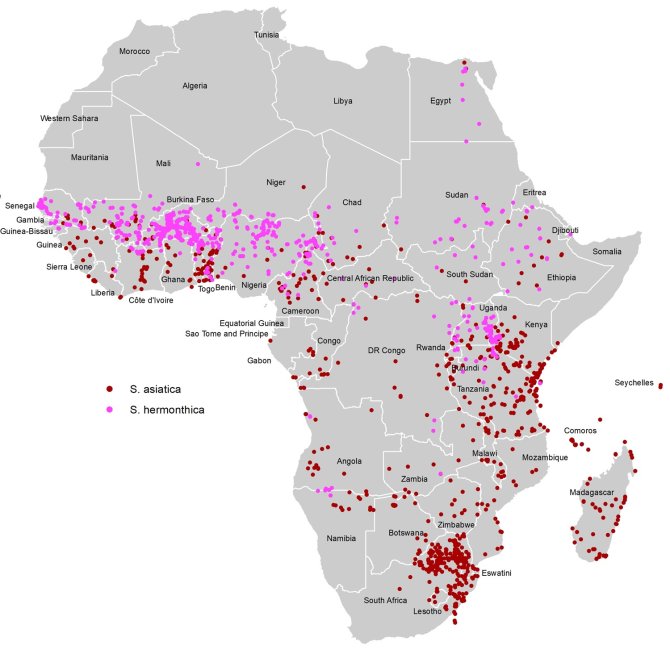Project
Controlling the parasitic weed Striga through soil-microbial volatiles
The research explores effects of soil-bacteria derived volatile organic compounds (VOCs) on germination or viability of seeds of the parasitic weed Striga (S. hermonthica and S. asiatica). Research questions are: (1) which microbial VOCs have potential to inhibit germination or reduce viability of striga seeds, (2) what are effective concentrations and seed exposure times of these VOC, (3) can striga-suppressive soil concentrations of VOCs be achieved through soil or crop management or inputs that are feasible/affordable for smallholders in Africa?
Project description
Striga hermonthica and S. asiatica are parasitic weeds that infest 12-38% of the area under cereal production in Africa (see distribution map). Striga causes substantial yield losses, leading to field abandonment and food insecurity for smallholder farmers. Resource-poor farming communities are most affected by these parasitic weeds as they rely heavily on these crops for their livelihood. Striga plants produce high numbers of long-lived seeds (up to 26,000 seeds per Striga plant), which easily replenishes and even increases the soil seedbank every cropping season. Control of these parasitic weeds is challenging because they have a relative long belowground stage during which they go unnoticed and are difficult to target. Waiting until striga plants emerge aboveground, for targeted interventions, is not a useful strategy as most of the damage to the host plants has then already been done. Striga therefore requires a timely and integrated management strategy. Targeting the Striga seed bank in the soil, preferably through multiple modes of action, is expected to result in the most effective and long-lasting control. However, because of the geography and farming systems where Striga is most problematic, technologies requiring high levels of external inputs, or high dependency on (local) markets, have a lower adoption rate. Therefore, the aim of one of CSA’s research projects PROMISE is to find integrated solutions based on locally available resources. The overall aim of PROMISE is to make soils more Striga suppressive. The approach studied here entails the identification and exploitation of strigacidal (microbial) volatile organic compounds. VOCs have been identified that either inhibit Striga seed germination or kill Striga seeds. Such strigacidal volatiles are di- or trisulfides produced by microbial (bacterial) decomposition of common sulfur-based amino-acids, such as
methionine. The proposed research project will investigate if and how this knowledge can be applied to an on-farm Striga management strategy. Three
approaches can be considered: (1) direct soil application of strigacidal volatiles, (2) direct soil application of precursors of such volatiles, i.e. sulfur-based amino-acids, or (3) elevation of sulfur-based amino-acids in the soil. The first two options (1 and 2), while being considered and tested, may be most effective and reliable but may not be affordable or available to smallholders in Africa. The latter option (3), although perhaps less reliable in terms of Striga control, may be (partly) locally sourced and therefore more affordable. To achieve these elevated levels of sulfur-based amino-acids in the soil we will explore (a) application of sulfates to crops, (b) application of sulfur-rich organic materials to the soil, (c) growing sulfur-rich companion or rotation crops, or (d) application of elemental sulfur in combination with organic matter. The effectiveness, mechanisms, concentrations and timings and overall feasibility of these applications will be investigated in this project.
Objectives and methods
The objectives of this project are to:
- find microbial VOCs with high potential to inhibit germination or reduce viability of striga seeds
- determine effective concentrations and seed exposure times of these VOC
- identify feasible and affordable soil or crop management practices or inputs that achieve striga-suppressive soil concentrations of VOCs

Expectations
Some experience with/understanding of experimental plant research, knowledge of plant – soil interactions and statistical knowledge and analytical skills would be expected.
Willingness to work (sometimes long hours) in the greenhouse would be expected.
Required skills
- Basic plant and soil science knowledge
- Experimental design and layout knowledge
- Basic (statistical) analytical skills
Types of research / work
A student project on this topic could involve all or components of the following research approaches: (1) a literature study and expert consultations aiming at identification of high-potential sulfur-rich organic sources and crops, (2) lab experiments in 2-compartment petri-dishes to test volatiles on Striga seeds, (3)
(sorghum, millet or rice) plant experiments to test organic soil amendments or
companion crops in the greenhouse in Wageningen in Striga-infested soils, (4) co-conducting field trials in Africa (Senegal or Ethiopia) to test effectiveness and
feasibility of applications in the field.
Period
Most research work can be conducted all year round; field work in Africa is season dependent.
Location
- Greenhouse on Wageningen Campus
- Senegal/Ethiopia (optional)